Chermside & Districts Historical Society
Chermside - the early years
Originally written by Pat O’Shea, 2010. Updated by Sherry Mackay, Julia van Zon, Bradley Scott, 2023.
The Huxtable Survey
In November 1864, Edward Huxtable had surveyed the future Chermside area and laid out the grid pattern of east-west and north-south roads which are used today.
There were no quarter-acre house blocks but paddocks varying in size from 8 to 30 acres with some larger including the 504-acre Murphy’s Paddock on Downfall Creek (1888 Surveyor General’s Map).
The hamlet of Downfall Creek developed between Dead Man’s Gully, where Somerset Creek crosses Gympie Road, and Downfall Creek to the north.
As the hamlet slowly grew, newcomers bought small acreages for houses and workshops. By the late 1890s some landowners began to subdivide their larger blocks into small house lots.
Possibly the earliest landowner to subdivide his land was Andrew Hamilton on the east side of Gympie Road. Gottlieb Conradi, who owned a store on the west side of Gympie Road also subdivided his land for sale to house builders.
The sales were probably slow as Downfall Creek was a fair distance from the Central Business District. The land offered by Hamilton was still being sold in the 1930s.
Our earliest photo of Chermside
Our earliest photo of the hamlet of Downfall Creek was taken in 1902. It was taken as a Hamilton family photo of Janie Hamilton, later Janie Wayper with her pony Silver and her dog. Fortunately for history, it also shows much of the hamlet in the background. This photo was taken approximately 38 years after the first Crown Lands survey of the area from the present Burnie Brae Park.
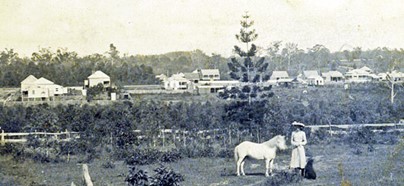
Image courtesy of the Hamilton family.
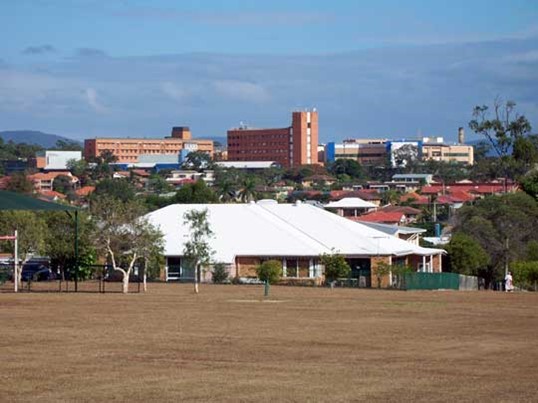
Chermside 2007 looking from Burnie Brae Park over Chermside. This is much the same position from which the 1902 photo was taken. The large white building is the Burnie Brae Respite Centre and on the skyline is the Chermside Hospital complex.

Excerpt from the 1888 Moreton 20 Chain Map Sheet No.8b showing the original location of the future Chermside. The east-west roads became Ellison, Hamilton and Rode while the north-south is Gympie Road. Murphy Road did not appear on Huxtable’s original map but was added later to make the short cut to Zillmere an official road.
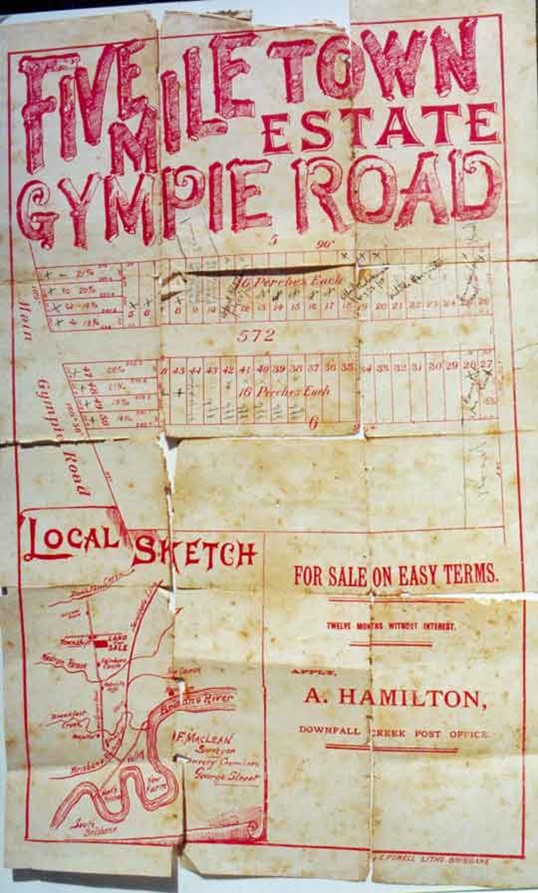
This lithograph would have been printed before 1897 which was the year Andrew Hamilton died. His son Thomas carried on the family business and the land sales.
Northern Roads
West: The Old Northern Road which comes from Spring Hill via McDowall to cross the South Pine River at Cash’s Crossing near modern Albany Creek was the earliest of the northern roads and simply forded the rivers because neither technology nor money was available to do otherwise.
The road was not suitable for heavy loads and the bridge at Albany Creek was not built until October 1892. It was also known as the Durundur Road as it led to the Archer Brothers’ cattle station of that name in the Woodford area.
The old road followed the Indigenous Australians pathway that Tom Petrie walked along with the Aboriginal People on their way to the great triennial intertribal Bunya nuts feast in the Bon-Yi Mountains (Blackall Range) in 1845.
Middle: The North Road, now Gympie Road, became viable when the first bridge over Breakfast Creek near the present Royal Brisbane Hospital was built possibly as early as 1862. Thomas Hamilton in his memoirs mentions crossing it as a child in 1869. It became much more important with the bridging of the South Pine River at Bald Hills in 1865. The road to Gympie was opened in October 1868 and Cobb & Co coaches began the run on 12 November 1868. Bridge-building technology and money supply had improved.
In 1972, Gympie Road split at Carseldine into Old Gympie Road and the Gympie Arterial Road; the former veers to the west and then north while the latter continues north to Gympie and beyond.
East: The new Gateway Motorway which skirts the coast and joins the Gympie Arterial to cross the Pine River at Strathpine and become the Bruce Highway which is part of the Pacific Highway. This road was built in conjunction with the Gateway Bridge over the Brisbane River at Murarrie in January 1986.
In May 2010, a second bridge was built providing 12 lanes of traffic, i.e. six in either direction. This road only marginally affects Chermside by diverting some of the traffic through the less settled or bushland areas.
Upgrading Gympie Road and increasing its importance
In 1865, the first bridge had been built over the South Pine River at Bald Hills and was opened by Governor Bowen. The main road suddenly acquired much more importance, and when gold was discovered the importance grew even more.
In early 1868 the Queensland Government allocated £2,700 for the construction of a road to Gympie.
On 12 November 1868 the first coach left Brisbane driven by Hiram Barnes and arrived in Gympie on Friday evening 13th November 1868.
When Andrew Hamilton travelled to Gympie in 1867 to find gold the trip took him two weeks on horseback and in some places the track was almost impossible to find. He was following a trail blazed by others using trees as markers. There was no road to Gympie then, but by 1868 “the knights of the long ribbons” were driving the coaches of Cobb & Co on a twice weekly, timetabled run from Brisbane to Gympie.
The second Northern Road from Central Business District was operational and provided a more direct route to Gympie and Downfall Creek was on that road.
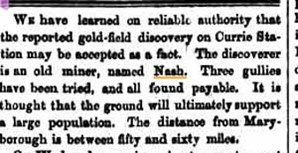
This note is possibly the first confirmation of the gold discovery near the future settlement of Gympie. It appeared in the Brisbane Courier 18 October 1867 on p.2. The gold rush was on and miners streamed into the new diggings. To read this article on Trove, click here.
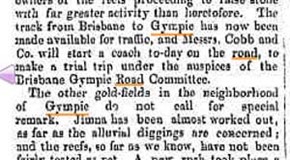
This cutting from the Brisbane Courier 6 Oct 1868 p. 2 indicates that the road to Gympie was click here.
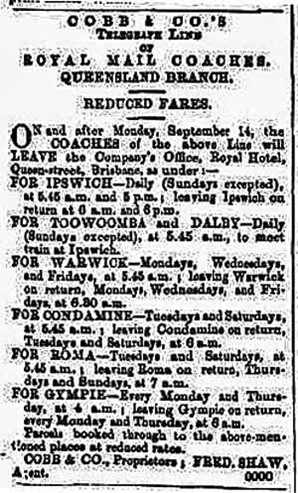
This advertisement appeared in the Brisbane Courier of 12 November 1868 p.1. It was the first notice of the inclusion of Gympie on Cobb & Co.’s weekly timetable from Brisbane. To read the full article on Trove, click here.
Upgrading Gympie Road and increasing its importance
It must be clearly understood that settlement gradually moved out from the early Central Business District in a gradual process to the north and this is reflected in the naming of the main road to the north.
The road from Brisbane to Chermside in the very early times was probably just a track marked out but not developed by sealing and bridging. The development of the road in sections was probably marked by the naming of each section. Brunswick Street, the earliest part, goes to Gregory Terrace; Bowen Bridge Road was probably named when the bridge was built over Enoggera/Breakfast Creek, Lutwyche Road when the road was extended to Lutwyche and Kedron Brook. Gympie Road probably marks the building of the road to Gympie in 1868 after the gold discovery in 1867.
Shopping centres appeared in the 19th century in the Brisbane CBD, then Lutwyche, then Chermside, then Aspley. These centres catered for the local area in groceries and fresh food but also had specialist shops and workshops which catered for the more expensive goods which were bought less frequently.
Means of transport played a big part in deciding the spacing of the small settlements along the main road just as it does today in the automobile age. In the pre-motor car age people could only travel short distances to do their weekly shopping.
The areas in between were catered for by the widespread corner store, which was oriented to the pedestrian traffic for a short distance around the shop and sold day-to-day items such as groceries and some fresh produce. The perishable items such as bread, meat, ice, rabbits, fish, and green groceries were supplied by horse-drawn carts on a door-to-door basis; fuel such as wood was delivered by the vendor who also might have supplied clothesline props.
When the automobile age began people were willing to travel longer distances and many of the earlier shopping centres were closed; the corner store has now all but disappeared.
The hamlet of Downfall Creek was just close enough to Central Business District for a sulky, buggy or spring cart to make a trip with produce to sell at the markets and do some shopping in the process if expensive items such as furniture, a sewing machine, jewellery or art works were to be purchased. On the other hand expensive horse-drawn vehicles were being manufactured and sold in Downfall Creek.
Early Settlement
John Patterson chose to build his general store directly to the south of Banfield Street because he estimated that there would be sufficient people living nearby who would choose to shop at his store rather than travel to Lutwyche for their supplies.
When he opened his store in 1868 there was no store in Kedron until King’s opened in 1891, possibly because of the proximity to Lutwyche.
Why he settled near Banfield Street rather than Hamilton Road is a mystery; maybe he got the land cheaper, but later shops including Conradi and Fisher tended to be south of Hamilton Road; however, Hacker set up on Banfield Street to the east and not far from Patterson’s shop.
Patterson’s choice of a trading spot was sound as it stood the test of time; under the Early family the business expanded and did not close until the early 1960s. By that time Chermside Drive-In Shopping Centre was thriving right beside it.
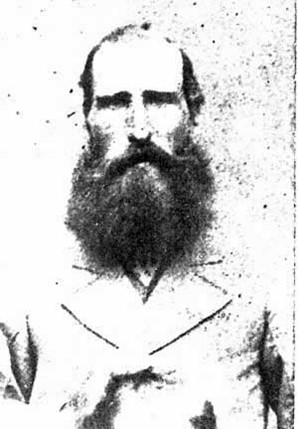
John Patterson, the first-known storekeeper in Downfall Creek. He had been a policeman in the Colony of Victoria and had bought two blocks of land in 1866 and built his store on the side of the main track, later Gympie Road.
A Stroke of Serendipity
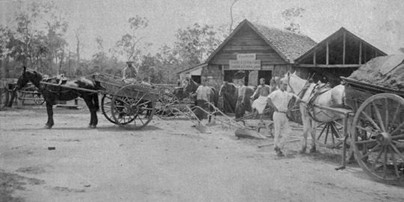
Andrew Hamilton’s Fivemiletown forge and carriage shop with customers waiting outside for attention. The small skillion roof on the left of the forge is the Post Office; Andrew was postmaster after John Patterson.
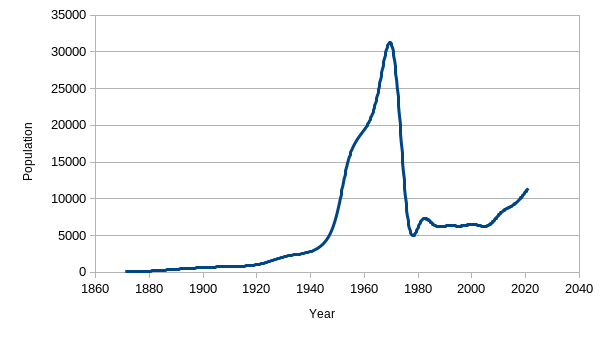
Population growth of the area from the 1870s to 2021 (Source: 2021 Census).
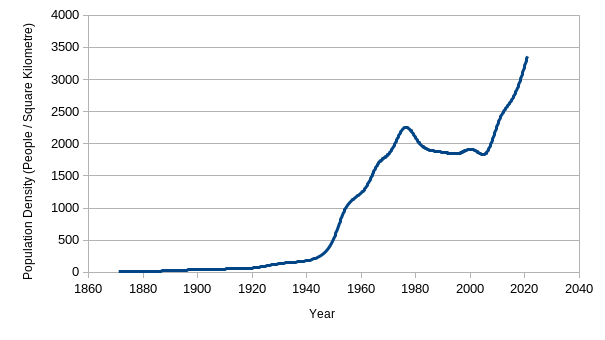
Population density (people/square kilometre) from the 1870s to 2021 (Source: 2021 Census).
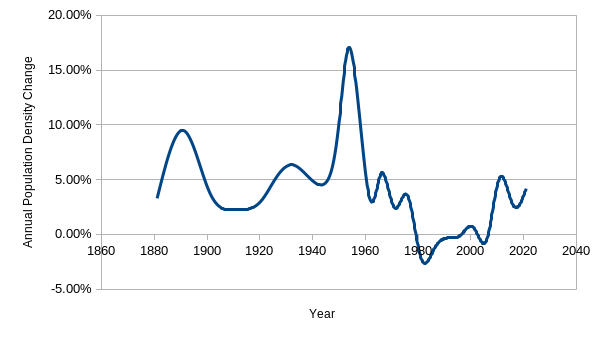
Annual population density change from 1880s to 2021 (Source: 2021 Census).
Then there seemed to be a stroke of serendipity when Andrew Hamilton came to farm in 1868 but found he could do better by following his trade of carpenter, joiner and wheelwright. He employed the first blacksmith in the hamlet and expanded into cart and carriage building. His son Thomas set up the first fuel depot supplying wood and coke to customers in the Kedron and Lutwyche areas.
This was the beginning of manufacturing in the local area and Downfall Creek grew to dominate in the surrounding district.
Smelly, obnoxious industries such as slaughter yards appeared to supply the butcher shops in the growing north Brisbane area. Tanneries, fellmongering and wool scours followed by settling on the numerous creeks to process the sheepskins and hides from the slaughter yards. Building tradesmen such as carpenters, bricklayers, painters, plumbers, fencing, well-sinking contractors came to live and work. Butcher, hairdresser, bootmaker and repairer, draper, saw miller, timber cutters, drover, etc., steadily appeared. A semi-independent village was in the process of growing in the small area along the present Gympie Road between Hamilton & Rode Roads. It was to keep on growing, steadily attracting more businesses.
In his 1973 book, History of Chermside (p.21), David Teague summed up the local business aspect of the early settlement:
Chermside is in a rather unique position as far as local business is concerned. It not only services its own district but many surrounding suburbs and it has done this for a hundred years. Chermside was the centre for the coachbuilders and blacksmiths, produce merchants and stores in the 19th century and it continues in a similar modern way today servicing the surrounding areas.
The growth of the village is reflected in the periodical census counts up to about the 1920s. The figures in the graph are the number of people living in the Chermside Statistical Division which included the farming community. Originally the area covered was 15.6km² but in 1975 the boundaries were changed and the area became 3.4km², hence the drop in Chermside’s population.
Downfall Creek - Chermside 1902
Sketch map of the hamlet of Downfall Creek in 1902 by Stan Eddowes was based on the photograph of Janie Hamilton which was taken in front of the Hamilton’s home of Burnie Brae overlooking the settlement of Downfall Creek. The section from the photograph is shown in between the diverging dotted lines. The remainder was plotted from local knowledge. The buildings are keyed into a list of the families living in them.
An estimate of the hamlet population can be made for 1902 using the above map, the list of 23 families and an average family size of six persons at the time. Thus Downfall Creek may have had about 140 persons in the 649 listed in the Downfall Creek Statistical Area at the 1901 census.
Chronology of Downfall Creek 1864-1902
1864: Edward Huxtable surveys the area of Downfall Creek and leaves the huge 504-acre block around Downfall Creek for posterity.
23 May 1865: First Chermside land sales held in Brisbane.
1866-7: Patterson Store on Banfield Street – taken over by George Early in 1888.
1869: Andrew Hamilton settles in present Burnie Brae Park to farm but turns to making carts, wheelwrighting and blacksmithing.
1873: The Methodist Church founded in a hut on Aaron Adsett’s land – the present Wheller Gardens.
1874: Chinaman’s Creek (now Albany Creek) Road opens – link with Old Northern Road.
1877: New church built on the corner of Banfield Street, which was used for important social as well as religious events. It then moved to the corner of Hamilton and Gympie Roads in 1926.
1879: Postal Receiving Office in Patterson’s store, which could have started as early as 1868 when Cobb & Co began their service to Gympie.
1880: Gottlieb Conradi opens the Polsloe Store on the west side of Gympie Road.
1884: Kedron Shire offices and clerk’s house built opposite Murphy Road and the first butcher, Daw & Slack opened.
1890s: Lodge Hall built and became the School of Arts in 1909. It was very important social, educational and library centre.
1891: Packer & Knox opened – Fellmonger, Wool Scour, Tanner.
1896: First definite subdivision for housing blocks in Downfall Creek by Andrew Hamilton – Fivemiletown Estate – same area in 1926 with 77 blocks and 1928 with 60 blocks.
1898: Vellnagel’s Blacksmith started on the north-east corner of Murphy and Gympie Roads.
1899: George Conradi butcher shop opened.
1880s-1890s: Tanneries, Wool Scours, Slaughterhouses/yards proliferate; blacksmiths, general stores. Water was obtained from wells, tanks and creek. Cooking was done using wood-fired stoves. Lighting was candles and oil lamps. Transport was horse and bullock. Houses were timber with galvanised iron or shingle roof. There were no medical, dental, hospital, banking, or legal services.
1900: Downfall Creek State School opens with 90 pupils.
1902: James Plucknett opens blacksmith shop.
1903: Downfall Creek renamed Chermside
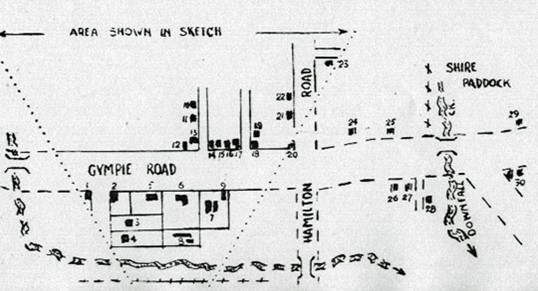
Map drawn by Stan Eddowes from a photograph of Janie Hamilton taken in 1902.
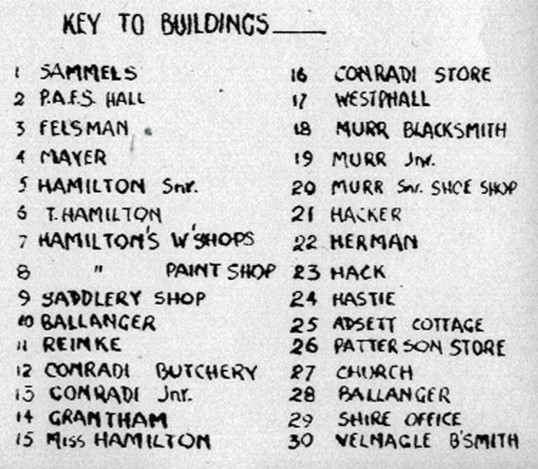
Key to numbers in the above map.
The Oldest Building in Chermside - August Vellnagel's Forge
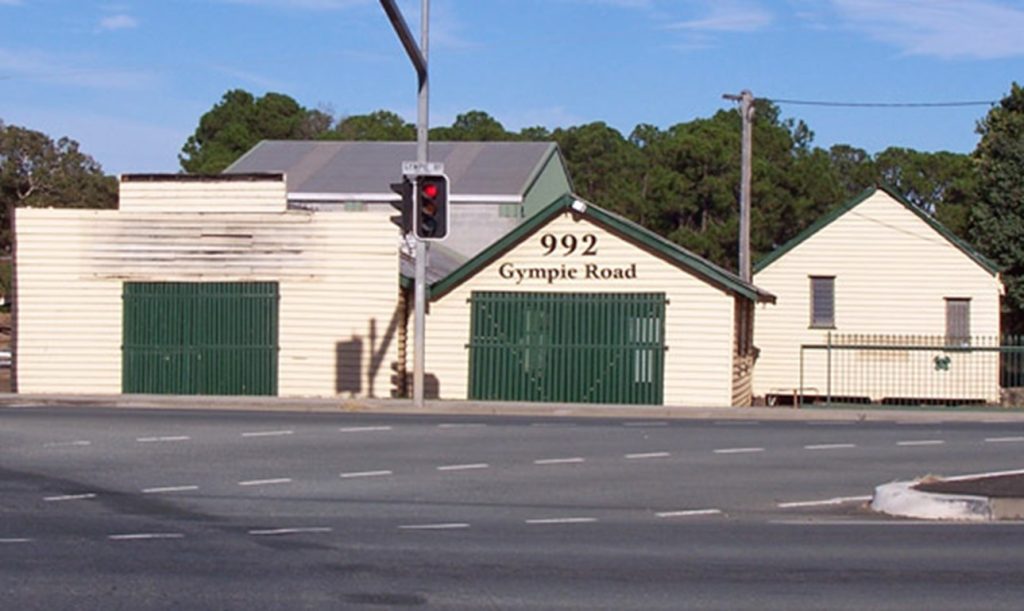
The original forge of August Vellnagel was fired up in 1897, shifted to the present site in 1921 and still stands in 2023. This photo was taken 13th April 2006. The shed on the left was the forge and the one in the middle was the workshop. The one on the right was a later building.
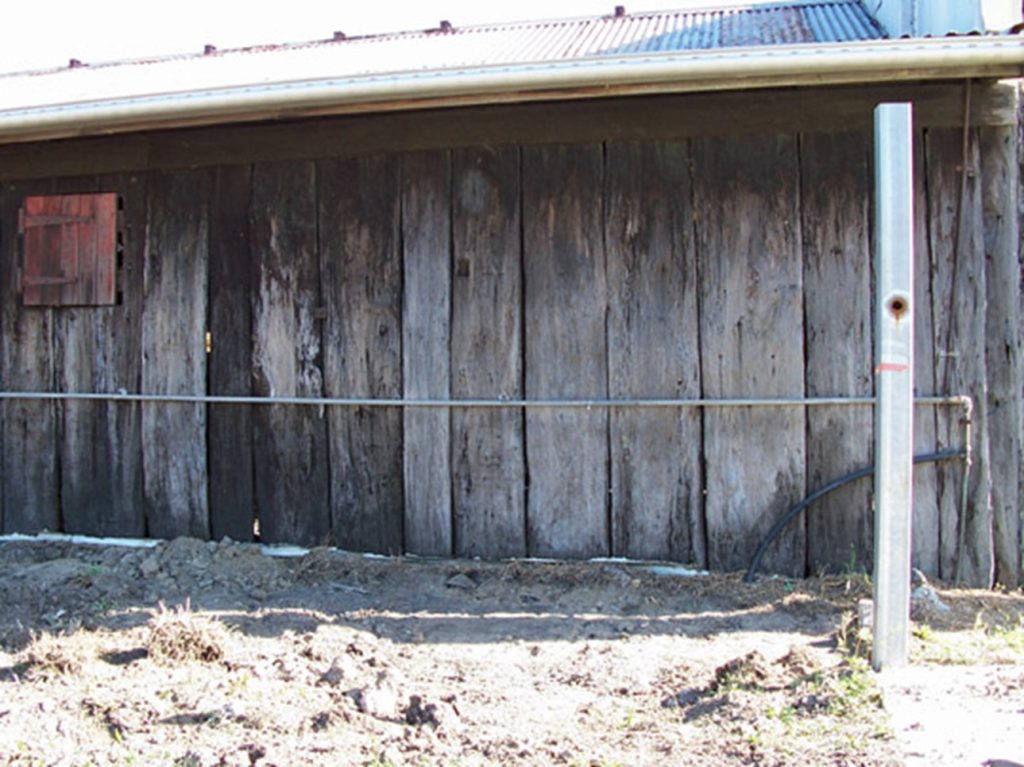
These vertical slabs of the forge are probably the original hardwood timbers which would have been split and adzed on site. The timber is still sound 125 years on and varies from 300mm to 400mm in width, about 50mm to 70mm in thickness and about 2m in length.
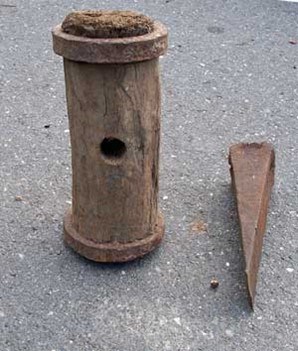
The maul and wedge belonged to Lindsay Staib and were used by his father to split fence posts and rails. The wedge is about 300mm long and about 50mm at its widest point while the maul is about 300mm by about 100mm in diameter.
When August and Christiana Vellnagel and family moved into Downfall Creek there was endless space available. He had four acres (1.6ha) on which to build his forge and loads of room for farmers to leave carts for repairs or horses to shoe.
There was plenty more room to build a house on the other side of the road and the children could play in the bush, walk down the road to school, and the local shops were an even shorter walk while the Church was just up the hill; they could take a buggy ride into the big city for a day’s shopping.
August died in 1932 aged 59 after a stomach operation; there were no antibiotics in those days. Fortunately, he had strong sons who continued the business.
Splitting slabs
Splitting slabs from a log was the alternative to ripping the log with a pit saw. It was cheaper and rougher and it was widely used for wall timbers in houses and workshops.
The maul was made from hardwood and bound either end with iron; the hole was for the handle. It weighed about four kilograms and it took a very fit, strong man to use it all day long. The maul being wood was softer than the iron wedge and did not damage the steel.
The splitter put a line of wedges in a solid log and hammered them until the log split. Sounds simple, and it was, but it took a lot of skill to produce good slabs.
Sales outlets in 1902 Downfall Creek
In the 47 years since the first land sale in Downfall Creek the hamlet had developed a basic settlement with a population of about 130-140 and at least 37 Sales Outlets. The population of the whole Downfall Creek Statistical Area at the 1901 Census was 649.
- General Stores (3): Sammells, Conradi, Hacker
- Drapery (1): Grantham
- Bootmaker/Shoe Store (2): Hansen, Christopher Murr
- Blacksmiths (3): Hamilton, Murr, Vellnagel
- Carriage Builder (1): Hamilton (employed up to 14 men)
- Government: Post Office, Shire Office, School
- Butcher (1): Conradi
- Hall (1): Protestant Alliance Friendly Society, Methodist Church, Methodist Church Orchestra
- Tanneries (6): Packer & Knox, Pills, Gallagher, Maggs, Slaney, Maunsell
- Slaughter Yards (6): Conradi, Cocks; Felsman and others
- Builders (2): James Hamilton, Ludwig Hermann,
- Wood Depots (2): Henry Beneke, Tom Hamilton
- Bone Mill/Fertilizer: Mentioned in Kedron Shire Minutes
- Carter-Drayman
- Sanitary (4)
- Saddler (1): G. C. Westphal
Source: Stan Eddowes’ c.1970 map of Downfall Creek + QPODs + 1903 Commonwealth Electoral Roll for Queensland + Teague’s History of Chermside + Minutes of Kedron Shire Council
Chronology of Chermside 1903-1936
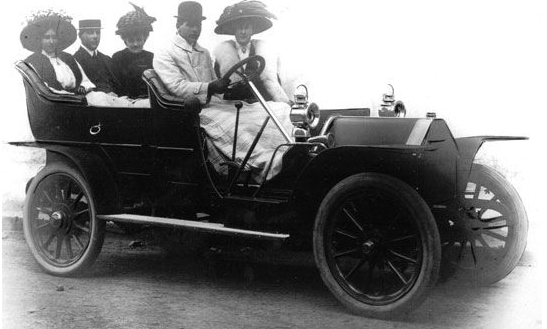
This fantastic photograph is of William George Early driving his Belsize motorcar in 1910 with his family members. The Early family owned a lovely old Queenslander on the corner of Gympie and Hamilton Road (where the Chermside bus station is now). Unfortunately, Mr Early was killed when cranking this motorcar, which had been left in gear.
1904: First Police Station opened, and closed in 1917.
1908: First telephone in Sammell’s store then moved outside later.
1908: Kedron Shire Cattle Dip opened in Chermside.
1909: First car in Chermside area, owned by the Early family.
1909: Alonzo Sparkes opened his slaughter yard & butcher (this area later became 7th Brigade Park).
1911: Water main laid along Gympie Road.
1914: All Saints, Anglican Church opened.
1921: The Marchant Family gave 100 acres of their property to be used as a park and is now Marchant Park.
1924: First automobile service station opened.
1925: Electric light arrives in Chermside.
1925: Electric trams arrive in the district with the last stop at Lutwyche Cemetery.
1928: Dawn Theatre opens with Silent films.
1928: Town water to Marchant Park.
1929: Police Station reopened.
1930: R. E. Stevens Sawmill opened, and Talkies start at the Dawn Theatre.
1931: Slaughter Yards closed
1933: Census indicates that Chermside could be classed as a small town, possibly the biggest in the Shire.
1936: Wheller Gardens opened.
Town water, electric light, and power, automobiles appearing, postal deliveries, Brisbane newspapers, telegrams.
Map of Chermside area in 1925
The map of Chermside in 1925 shows how the village has grown on the west side of Gympie Road and south towards Kedron, which is more developed as it is closer to Brisbane. By this time the tram had reached Lutwyche Cemetery and the housing had followed the cheap transport.
The main east/west streets are Hamilton and Rode Roads.
The minor streets on the east side are Banfield, Kuran, and Kingsmill. The minor streets on the west side are Latham, Sparkes, and Wallace.
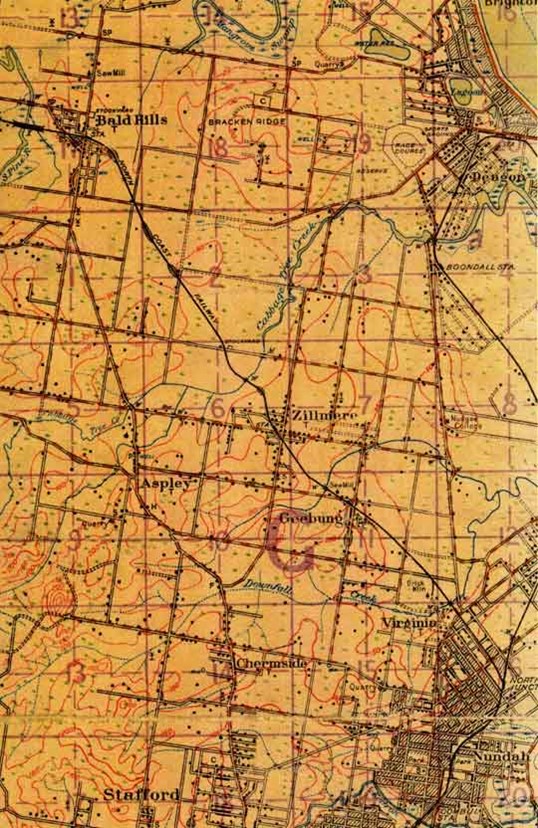
The map shows that there is little settlement along Gympie Road northward from Chermside to Bald Hills where rail and road meet.
